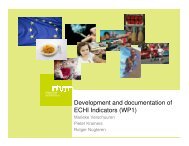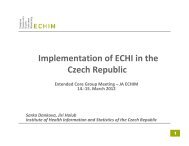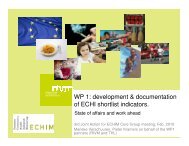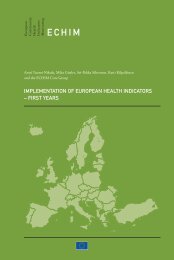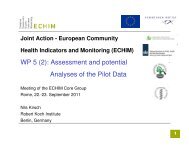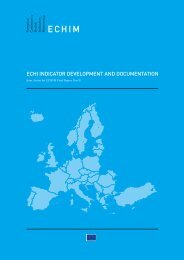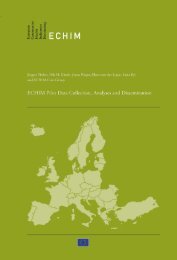INDICATORS
ECHIM Final Report
ECHIM Final Report
Create successful ePaper yourself
Turn your PDF publications into a flip-book with our unique Google optimized e-Paper software.
9. POPULATION BELOW POVERTY LINE AND INCOME INEQUALITY<br />
Definition:<br />
1) Population at risk of poverty rate is defined as share of persons with an equivalised<br />
disposable income below national poverty line, i.e. below 60% of the national median<br />
equivalised disposable income.<br />
2) Income inequality is defined as the income quintile share ratio S80/S20, which is the ratio<br />
of total income received by the 20% of the country’s population with the highest income<br />
(top quintile) to that received by the 20% of the country’s population with the lowest<br />
income (lowest quintile). Income is understood as equivalised disposable income.<br />
Calculation:<br />
1a) Population at risk of poverty rate is calculated as the percentage of persons in the total<br />
population with an equivalised disposable income below the “national poverty line” (i.e.<br />
below 60% of the national median equivalised disposable income) over the total population.<br />
Total population is all persons living in private household on the national territory. Personal<br />
equivalised income is obtained by dividing the total household disposable income by the<br />
equivalised size of the household, using modified OECD scale: 1 for the first person aged 14<br />
or more; 0.5 for any subsequent person aged 14 or more; and 0.3 for persons aged less then<br />
14.<br />
1b) Children in poverty: percentage of children (out of all children) living in households<br />
with an equivalised disposable income below the “national poverty line” (i.e. below 60%<br />
of the national median equivalised disposable income). Presented for age groups 0–4, 5–9,<br />
10–14 and 15–17. Precise operationalisation of how to derive the indictor from EU-SILC to<br />
be formulated.<br />
2) Income inequality is calculated as the ratio of the sum of equivalised disposable income<br />
received by the 20% of the country’s population with the highest equivalised disposable<br />
income (top inter-quintile interval) to that received by the 20% of the country’s population<br />
with the lowest equivalised disposable income (lowest inter-quintile interval).<br />
Notes: Age groups: total, 0–17, 18–64, 65+. Equivalised income takes account of the size<br />
and composition of the household, and is attributed to each household member (including<br />
children). Related concepts are: “At-persistent-risk-of-poverty rate” and “Any time at-riskof<br />
poverty”. Disposable income can be calculated before social transfers (original income<br />
including pensions but excluding all other social transfers) and after social transfers (total<br />
income). “Population at risk of poverty” and “Income inequality” are EU structural<br />
indicators<br />
10. LIFE EXPECTANCY<br />
Definition: Life expectancy at birth is a summary measure of the age-specific all cause<br />
mortality rates in an area in a given period. It is the average number of years a new-born<br />
baby would survive, were he or she to experience the particular area’s age-specific mortality<br />
rates for that time period throughout his or her life. Life expectancy can be calculated<br />
starting at different ages. Here we present minimally: 1) Life expectancy at birth and 2) Life<br />
expectancy at age 65.<br />
89



